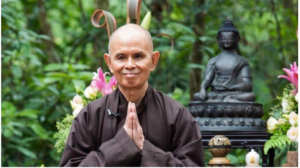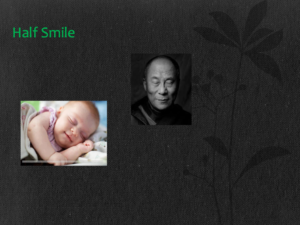Mindfulness Practice for Joy and Contentment
Mindfulness Practice for Joy and Contentment
This is Thich Nhat Hanh, the Buddhist Vietnamese monk and teacher who has written many helpful books on
mindfulness.
Today’s mindfulness is about cultivating joy and contentment in one’s life.

What brings joy? Having connections to people and activities that are important, achieving goals, noticing beauty in the world. All of these things may bring happiness. When we see a movie with a happy ending, we experience a positive emotion. When we see a child full of laughter and happiness, we smile. When we see or get to be with a sweet dog or cat, we experience pleasant feelings.
Mindfulness is about training your mind so that you tune into those moments and so that you do not notice or weigh unpleasant moments any more than pleasant ones. But, if we are honest, there are times when life circumstances provide an imbalance of negative experiences. That does not mean that even through difficulties we cannot experience joy. Anne Frank wrote of joy, even as she hid in an attic, in fear of Nazi’s. How is this possible?
Connecting to each moment without distorting means that some moments will offer contentment, joy, or happiness. Today’s practice though is for times when you would like to experience happiness, safety, joy, or contentment, even if that is your current experience. Thich Nhat Hanh said the following…
Sometimes your joy is the source of your smile, but sometimes your smile can be the source of your joy.
Modern neuroscience tells us that neuronal pathways are like roads through the woods. The more we travel the path, the faster we can go. So if we practice breathing every day, we will get to calm much quicker because our breath makes it a familiar route that is well traveled. What is very interesting though is that those pathways go both ways. So if I see something sweet, I experience happiness, and my face naturally smiles. The two are connected…the experience of joy and the smile. We tend to think the sweet thing makes us smile (and it does), but because the smile and the emotion are connected almost imperceptibly, they happen together always. So, if you want to experience the feeling, all you need to do is to control your facial expression. Remarkably, if I sit and gently smile, it is associated in my brain with the experience of joy. This means that we can access joy whenever we want, through the experience of a gentle smile.
For Today’s practice, sit comfortably and prepare. Take a few breaths in and out. Look at the images of the Dalai Lama and this baby. They both have expressions of joy or contentment. For the baby it is a natural expression, derived from the fact that she is fed, relaxed, and resting. For the Dalai Lama, it is an intentional practice. Your task will be to hold your face in a position of contentment like these two images. You may wish to scrunch up your face and then relax it so it’s easier to adopt the half-smile. The trick is to have just the corners of your mouth upturned.
You can close your eyes and imagine smiling with your eyes. If it is easier, you can begin by thinking about someone or something that naturally brings a feeling of joy to you. Then you will practice by breathing while half smiling. If you like, you can say, “breathing in, I know all is well in this moment, breathing out I smile…”
Try this practice for 10 minutes. When practiced, it generates feelings of joy and a feeling of well-being. You can do the half-smile for joy, you can do it while angry (to shift feelings), you can do it while walking…

I believe this mindfulness practice is the single fastest way to feel the impact of mindfulness in your life. Try it…
Michele
























